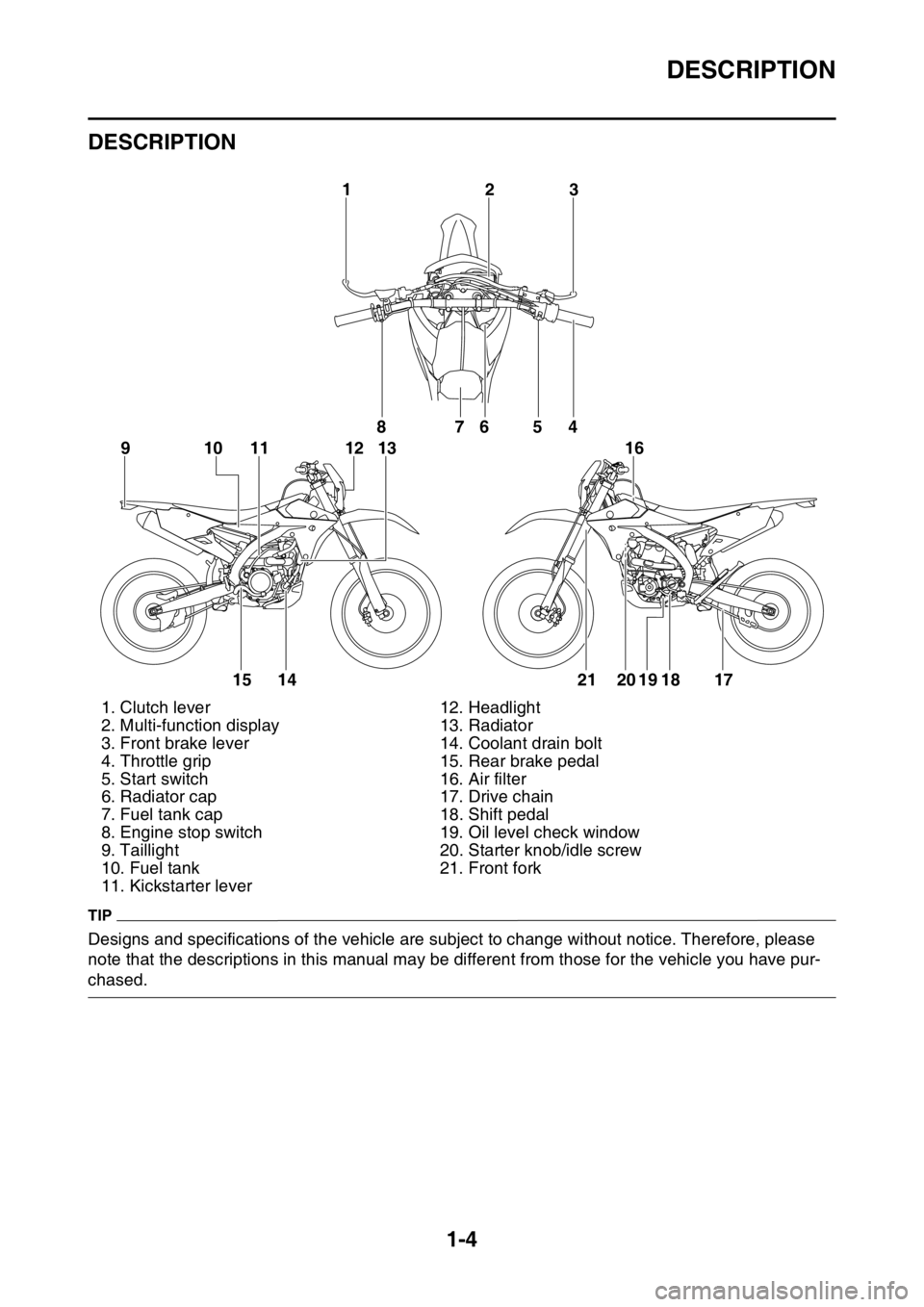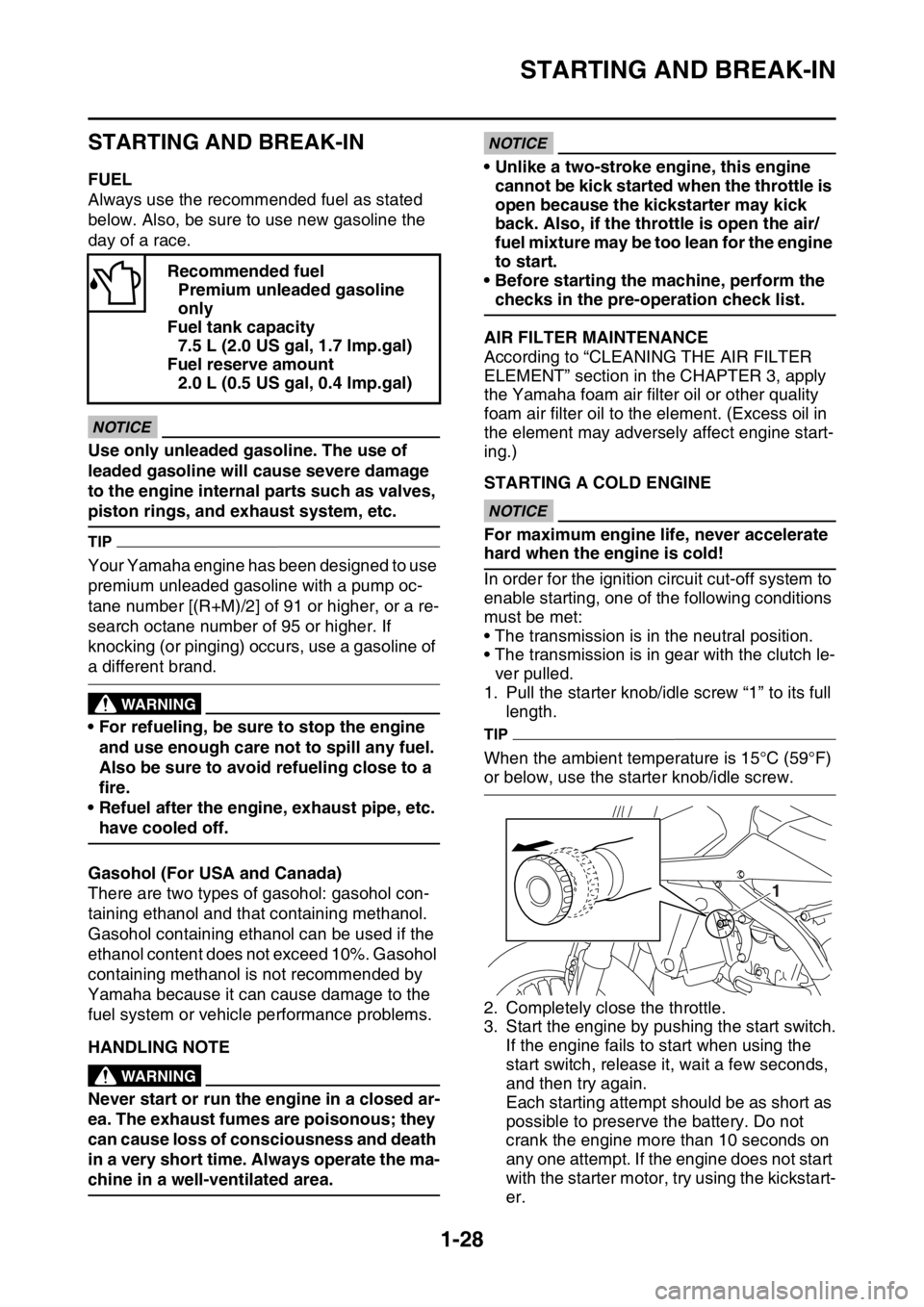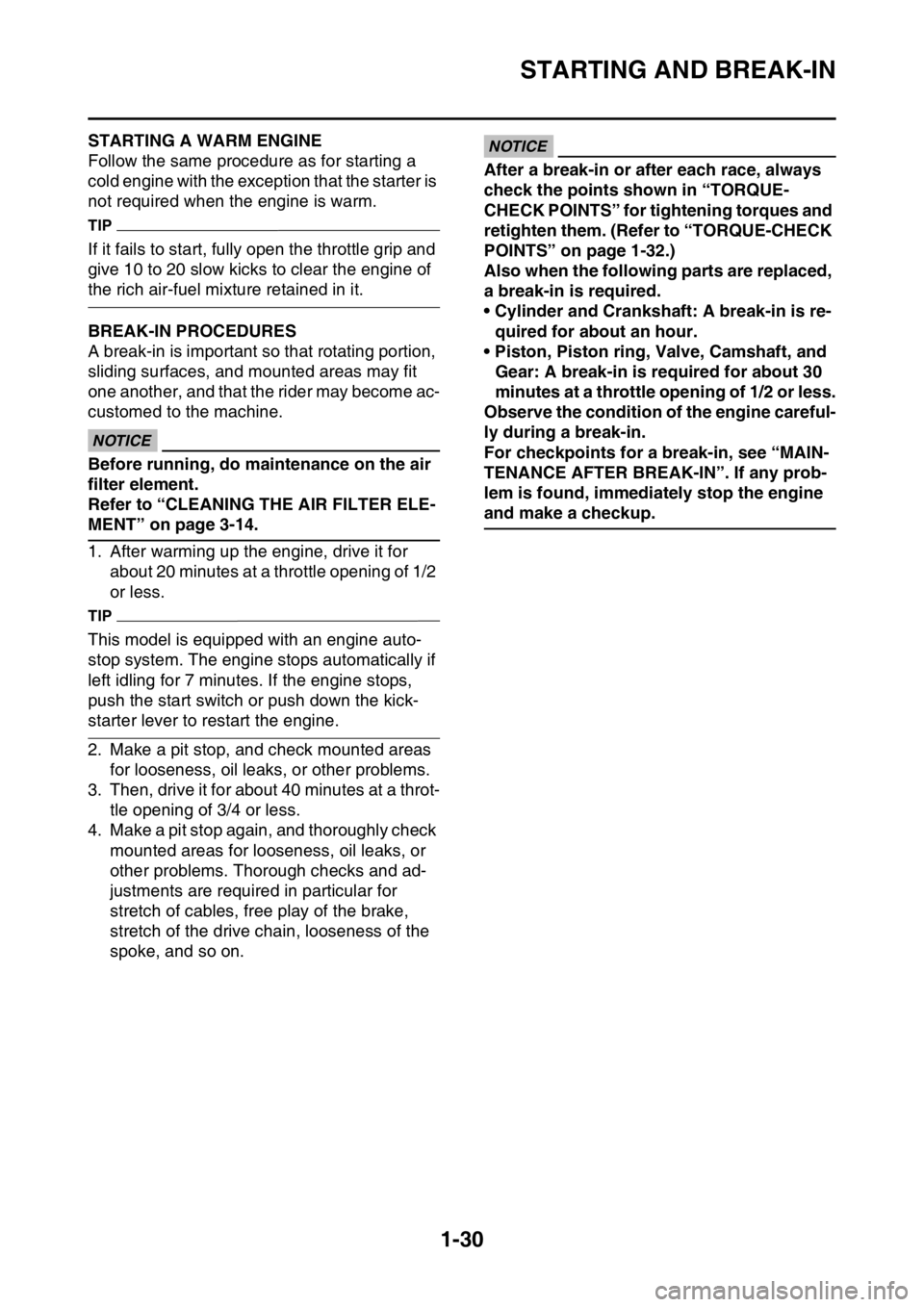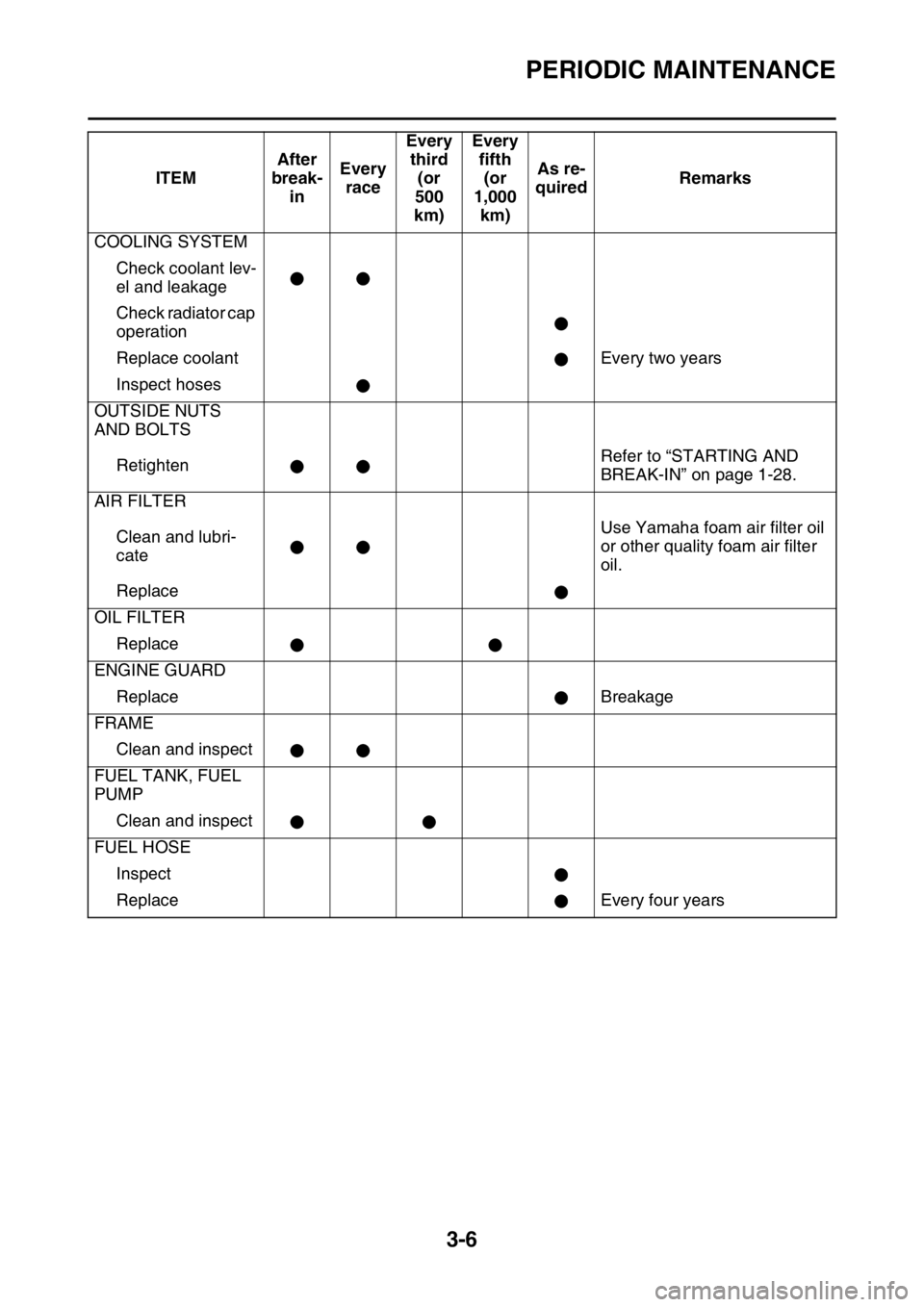fuel filter YAMAHA WR 450F 2016 Owners Manual
[x] Cancel search | Manufacturer: YAMAHA, Model Year: 2016, Model line: WR 450F, Model: YAMAHA WR 450F 2016Pages: 426, PDF Size: 10.86 MB
Page 14 of 426

MULTI-FUNCTION DISPLAY......................................................................... 1-21
DESCRIPTION ......................................................................................... 1-21
BASIC MODE ........................................................................................... 1-21
CHANGEOVER TO BASIC MODE /RACE MODE.................................... 1-22
RACE MODE ............................................................................................ 1-23
FUNCTION DIAGRAM ............................................................................. 1-26
STARTING AND BREAK-IN .......................................................................... 1-28
FUEL ........................................................................................................ 1-28
HANDLING NOTE .................................................................................... 1-28
AIR FILTER MAINTENANCE ................................................................... 1-28
STARTING A COLD ENGINE .................................................................. 1-28
STARTING A WARM ENGINE ................................................................. 1-30
BREAK-IN PROCEDURES .... .................................................................. 1-30
MAINTENANCE AFTER BREAK-IN .............................................................. 1-31
MAJOR MAINTENANCE .......................................................................... 1-31
TORQUE-CHECK POINTS ............................................................................ 1-32
MOTORCYCLE CARE AND STORAGE ........................................................ 1-34
CARE........................................................................................................ 1-34
STORAGE ................................................................................................ 1-35
Page 18 of 426

DESCRIPTION
1-4
EAS2GC1009
DESCRIPTION
TIP
Designs and specifications of the vehicle are subject to change without notice. Therefore, please
note that the descriptions in this manual may be different from those for the vehicle you have pur-
chased.1. Clutch lever 12. Headlight
2. Multi-function display 13. Radiator
3. Front brake lever 14. Coolant drain bolt
4. Throttle grip 15. Rear brake pedal
5. Start switch 16. Air filter
6. Radiator cap 17. Drive chain
7. Fuel tank cap 18. Shift pedal
8. Engine stop switch 19. Oil level check window
9. Taillight 20. Starter knob/idle screw
10. Fuel tank 21. Front fork
11. Kickstarter lever
32
1
8
10
91 112 1376
54
15 14 21 20 19 18 17 16
Page 42 of 426

STARTING AND BREAK-IN
1-28
EAS2GC1048
STARTING AND BREAK-IN
EAS2GC1049FUEL
Always use the recommended fuel as stated
below. Also, be sure to use new gasoline the
day of a race.
ECA
NOTICE
Use only unleaded gasoline. The use of
leaded gasoline will cause severe damage
to the engine internal parts such as valves,
piston rings, and exhaust system, etc.
TIP
Your Yamaha engine has been designed to use
premium unleaded gasoline with a pump oc-
tane number [(R+M)/2] of 91 or higher, or a re-
search octane number of 95 or higher. If
knocking (or pinging) occurs, use a gasoline of
a different brand.
EWA
WARNING
• For refueling, be sure to stop the engine and use enough care not to spill any fuel.
Also be sure to avoid refueling close to a
fire.
• Refuel after the engine, exhaust pipe, etc.
have cooled off.
Gasohol (For USA and Canada)
There are two types of gasohol: gasohol con-
taining ethanol and that containing methanol.
Gasohol containing ethanol can be used if the
ethanol content does not exceed 10%. Gasohol
containing methanol is not recommended by
Yamaha because it can cause damage to the
fuel system or vehicle performance problems.
EAS2GC1050HANDLING NOTEEWA
WARNING
Never start or run the engine in a closed ar-
ea. The exhaust fumes are poisonous; they
can cause loss of consciousness and death
in a very short time. Always operate the ma-
chine in a well-ventilated area.
ECA
NOTICE
• Unlike a two-stroke engine, this engine cannot be kick started when the throttle is
open because the kickstarter may kick
back. Also, if the throttle is open the air/
fuel mixture may be too lean for the engine
to start.
• Before starting the machine, perform the
checks in the pre-operation check list.
EAS2GC1051AIR FILTER MAINTENANCE
According to “CLEANING THE AIR FILTER
ELEMENT” section in the CHAPTER 3, apply
the Yamaha foam air filter oil or other quality
foam air filter oil to the element. (Excess oil in
the element may adversely affect engine start-
ing.)
EAS2GC1052STARTING A COLD ENGINEECA
NOTICE
For maximum engine life, never accelerate
hard when the engine is cold!
In order for the ignition circuit cut-off system to
enable starting, one of the following conditions
must be met:
• The transmission is in the neutral position.
• The transmission is in gear with the clutch le- ver pulled.
1. Pull the starter knob/idle screw “1” to its full length.
TIP
When the ambient temperature is 15°C (59°F)
or below, use the starter knob/idle screw.
2. Completely close the throttle.
3. Start the engine by pushing the start switch.If the engine fails to start when using the
start switch, release it, wait a few seconds,
and then try again.
Each starting attempt should be as short as
possible to preserve the battery. Do not
crank the engine more than 10 seconds on
any one attempt. If the engine does not start
with the starter motor, try using the kickstart-
er.
Recommended fuel
Premium unleaded gasoline
only
Fuel tank capacity 7.5 L (2.0 US gal, 1.7 lmp.gal)
Fuel reserve amount 2.0 L (0.5 US gal, 0.4 Imp.gal)
1
Page 44 of 426

STARTING AND BREAK-IN
1-30
EAS2GC1053STARTING A WARM ENGINE
Follow the same procedure as for starting a
cold engine with the exception that the starter is
not required when the engine is warm.
TIP
If it fails to start, fully open the throttle grip and
give 10 to 20 slow kicks to clear the engine of
the rich air-fuel mixture retained in it.
EAS2GC1054BREAK-IN PROCEDURES
A break-in is important so that rotating portion,
sliding surfaces, and mounted areas may fit
one another, and that the rider may become ac-
customed to the machine.
ECA
NOTICE
Before running, do maintenance on the air
filter element.
Refer to “CLEANING THE AIR FILTER ELE-
MENT” on page 3-14.
1. After warming up the engine, drive it for about 20 minutes at a throttle opening of 1/2
or less.
TIP
This model is equipped with an engine auto-
stop system. The engine stops automatically if
left idling for 7 minutes. If the engine stops,
push the start switch or push down the kick-
starter lever to restart the engine.
2. Make a pit stop, and check mounted areas
for looseness, oil leaks, or other problems.
3. Then, drive it for about 40 minutes at a throt- tle opening of 3/4 or less.
4. Make a pit stop again, and thoroughly check mounted areas for looseness, oil leaks, or
other problems. Thorough checks and ad-
justments are required in particular for
stretch of cables, free play of the brake,
stretch of the drive chain, looseness of the
spoke, and so on.
ECA
NOTICE
After a break-in or after each race, always
check the points shown in “TORQUE-
CHECK POINTS” for tightening torques and
retighten them. (Refer to “TORQUE-CHECK
POINTS” on page 1-32.)
Also when the following parts are replaced,
a break-in is required.
• Cylinder and Crankshaft: A break-in is re-quired for about an hour.
• Piston, Piston ring, Valve, Camshaft, and
Gear: A break-in is required for about 30
minutes at a throttle opening of 1/2 or less.
Observe the condition of the engine careful-
ly during a break-in.
For checkpoints for a break-in, see “MAIN-
TENANCE AFTER BREAK-IN”. If any prob-
lem is found, immediately stop the engine
and make a checkup.
Page 53 of 426

ENGINE SPECIFICATIONS
2-2
EAS2GC1062
ENGINE SPECIFICATIONS
EngineEngine type Liquid cooled 4-stroke, DOHC
Displacement 449 cm
3
Number of cylinders Single cylinder
Bore stroke 97.0 60.8 mm (3.82 2.39 in)
Compression ratio 12.5:1
Starting system Electric starter and kickstarter
Fuel
Recommended fuel Premium unleaded gasoline only
Fuel tank capacity 7.5 L (2.0 US gal, 1.7 Imp.gal)
Fuel reserve amount 2.0 L (0.5 US gal, 0.4 Imp.gal)
Engine oilLubrication system Wet sump
Recommended brand YAMALUBE
Type SAE 10W-40, SAE 10W-50, SAE 15W-40, SAE 20W-40 or SAE 20W-50
Recommended engine oil grade API service SG type or higher, JASO standard MA
Engine oil quantity
Quantity (disassembled) 0.95 L (1.00 US qt, 0.84 Imp.qt)
Oil change 0.67 L (0.71 US qt, 0.59 Imp.qt)
With oil filter removal 0.69 L (0.73 US qt, 0.61 Imp.qt)
Oil filterOil filter type Paper
Bypass valve opening pressure 40.0–80.0 kPa (0.40–0.80 kgf/cm
2,
5.8–11.6 psi)
Oil pump Oil pump type Trochoid
Inner-rotor-to-outer-rotor-tip clear ance 0.000–0.150 mm (0.0000–0.0059 in)
Limit 0.20 mm (0.0079 in)
Outer-rotor-to-oil-pump-housing clearance 0.13–0.18 mm (0.0051–0.0071 in)
Limit 0.24 mm (0.0094 in)
Oil-pump-housing-to -inner-and-outer-rotor
clearance 0.06–0.11 mm (0.0024–0.0043 in)
Limit 0.17 mm (0.0067 in)
Cooling system
Radiator (including all routes) 1.03 L (1.09 US qt, 0.91 Imp.qt)
Radiator capacity 0.57 L (0.60 US qt, 0.50 Imp.qt)
Radiator cap valve opening pressure 107.9–137.3 kPa (1.08–1.37 kg/cm
2,
15.6–19.9 psi)
Radiator core Width 112.6 mm (4.43 in)
Height 235.0 mm (9.25 in)
Depth 28.0 mm (1.10 in)
Water pump
Water pump type Single suction centrifugal pump
Spark plug(s)Manufacturer/model NGK/CR8E
Spark plug gap 0.7–0.8 mm (0.028–0.031 in)
Page 87 of 426

CABLE ROUTING DIAGRAM
2-36
1. Clamp
2. Throttle position sensor lead
3. Joint coupler
4. Intake air temperature sensor lead
5. Intake air pressure sensor lead
6. Wire harness
7. Injector lead
8. Injector coupler
9. Throttle body
10. Cylinder head breather hose
11. Engine ground sub-lead
12. Plate
13. Engine ground sub-lead coupler
14. Starter motor lead
15. Plastic band
16. Fuel sender coupler
17. High tension cord
18. Spark plug cap
19. Cylinder head cover
20. Fuel hose
21. Fuel sender
22. Sub-wire harness
23. Radiator breather hose
24. Radiator hose
25. Down tube
26. Starter motor cover
27. Starter motor
28. AC magneto lead
29. Clutch cable
30. Neutral switch lead
31. Radiator
32. Breather hose clamp
33. Grommet (high tension cord)
34. ECU
35. Air filter case
36. Sub-wire harness coupler
37. Engine bracket
A. Fix the wire harness, clutch switch lead and start switch lead by the plasti c clamp, and insert the
projection of the plastic clamp into the hole in the
sheet metal of the radiator.
B. Route each lead so that the leads are not pinched between the tank rail and air filter joint.
C. Insert the projection of the wire harness into the hole in the frame.
D. Pass the cylinder head breather hose between the throttle cable and engine ground sub-lead.
E. Insert the engine ground sub-lead coupler into the plate, facing inside the vehicle.
F. Connect the sub-wire harness to the wire har- ness.
G. Pass the high tension cord above the fuel hose.
H. ±10°
I. Install the spark plug cap with this facing the right
of the vehicle.
J. Push the spark plug cap home, where there shall be no gap between it and the cylinder head cover.
K. Pass the radiator breather hose between the down tubes.
L. Pass the starter motor lead under the starter mo- tor shaft.
M. Pass the sub-wire harness between the ECU and the air filter case.
N. Apply adhesive to the s lit and inside of the grom-
met, and then fix the grommet according to the
specified dimensions.
O. 50±3 mm (2.0±0.12 in)
P. Insert the coupler of the sub-wire harness into the
rib of the air filter case. Q. Clamp the starter motor lead, point the clamp
downward, and insert it into the frame.
R. Route the radiator breather hose through be- tween the radiator hose, down tube and engine
bracket.
Page 89 of 426

CABLE ROUTING DIAGRAM
2-38
1. Cable guide
2. Speed sensor lead
3. Joint coupler
4. Ground lead
5. Throttle position sensor lead
6. Throttle position sensor coupler
7. Radiator breather hose
8. Radiator hose
9. Fuel hose
10. Coolant temperature sensor coupler
11. Radiator fan motor lead
12. Intake air pressure sensor coupler
13. Intake air temperature sensor coupler
14. Start switch coupler
15. Radiator fan motor coupler
16. Clutch switch coupler
17. Air filter case
18. Plate
19. Bracket
20. Radiator hose clamp
A. Pass the wire harness under the start switch lead
and clutch switch lead.
B. Insert and fix the joint co upler to the plate. After
fixing it, attach the cover.
C. Pass the throttle position sensor lead to the out- side of the tension arm (the outside of the vehi-
cle).
D. After connecting the throttle position sensor cou- pler, attach the cover.
E. Pass the radiator breather hose to the outside of the tension arm and the throttle position sensor
lead (the outside of the vehicle), and to the front
of the radiator hose (the side of the vehicle).
F. Attach the coupler cover to the coolant tempera- ture sensor coupler.
G. Pass the radiator fan motor lead to the inside of the tension arm (the side of the vehicle).
H. Install the ground lead terminal between the plate and the bolt.
I. Fix the ground lead terminal to the detent in the plate. For the ground lead terminal, either side
will do.
J. Detent
K. Route the radiator breather hose between the frame and the radiator fan motor lead coupler so
that the breather hose is not pinched.
L. Install the radiator hose clamp with the locking portion facing the front of the vehicle and tighten
the screw from the right side of the vehicle.
M. Install the radiator hose with the positioning mark facing the rear of the vehicle.
Page 97 of 426

3
PERIODIC CHECKS AND ADJUSTMENTS
PERIODIC MAINTENANCE............................................................................. 3-1
INTRODUCTION ........................................................................................ 3-1
PERIODIC MAINTENANCE CHART FOR THE EMISSION
CONTROL SYSTEM ....................... .......................................................... 3-1
GENERAL MAINTENANCE AND LUBRICATION CHART ........................ 3-2
MAINTENANCE INTERVALS FOR COMPETITION USE ......................... 3-4
PRE-OPERATION INSPECTION AND MAINTENANCE ................................. 3-9
GENERAL INSPECTION AND MAINTENANCE........................................ 3-9
ENGINE .......................................................................................................... 3-10
CHECKING THE COOLANT LEVEL ........................................................ 3-10
CHECKING THE COOLING SYSTEM ..................................................... 3-10
CHANGING THE COOLANT.................................................................... 3-10
CHECKING THE RADIATOR CAP .......................................................... 3-11
CHECKING THE RADIATOR CAP VALVE OPENING PRESSURE ....... 3-11
CHECKING THE COOLANT CIRCULATORY SYSTEM FOR LEAKS .... 3-12
ADJUSTING THE CLUTCH LEVER FREE PLAY .................................... 3-12
ADJUSTING THE THROTTLE GRIP FREE PLAY .................................. 3-13
LUBRICATING THE THROTTLE CABLE ................................................ 3-14
CLEANING THE AIR FILTER ELEMENT................................................. 3-14
CHECKING THE THROTTLE BODY JOINT ............................................ 3-15
CHECKING THE BREATHER HOSES .................................................... 3-15
CHECKING THE EXHAUST SYSTEM............................. ........................ 3-15
CHECKING THE FUEL LINE ................................................................... 3-16
CHECKING THE ENGINE OIL LEVEL............................. ........................ 3-16
CHANGING THE ENGINE OIL ................................................................ 3-17
ADJUSTING THE ENGINE IDLING SPEED ......... ................................... 3-19
ADJUSTING THE VALVE CLEARANCE ................................................. 3-20
CLEANING THE SPARK ARRESTER ..................................................... 3-24
CHASSIS ........................................................................................................ 3-25
BLEEDING THE BRAKE SYST EM .......................................................... 3-25
CHECKING THE BRAKE HOSE .............................................................. 3-26
ADJUSTING THE FRONT BRAKE .......................................................... 3-26
ADJUSTING THE REAR BRAKE ............................................................. 3-27
CHECKING THE FRONT BR AKE PADS ................................................. 3-27
CHECKING THE REAR BRAKE PADS ........................... ........................ 3-29
CHECKING THE REAR BRAKE PAD INSULATOR ................................ 3-30
CHECKING THE BRAKE FLUID LEVEL.................................................. 3-30
ADJUSTING THE DRIVE CHAIN SLACK ................................................ 3-31
CHECKING THE FRONT FORK LEGS ................................................... 3-31
CHECKING THE FRONT FORK PROTECTOR GUIDE .......................... 3-32
CLEANING THE FRONT FORK OI L SEAL AND DUST SEAL ................ 3-32
AIR BLEEDING FROM FRONT FORK .................................................... 3-32
ADJUSTING THE FRONT FORK LEGS .................................................. 3-33
CHECKING THE SWINGARM OPERATION ........................................... 3-34
CHECKING THE REAR SUSPENSION ................................................... 3-34
Page 99 of 426

PERIODIC MAINTENANCE
3-1
EAS2GC1074
PERIODIC MAINTENANCE
EAS2GC1075INTRODUCTION
This chapter includes all information necessary to perform recommended checks and adjustments.
If followed, these preventive maintenance procedures will ensure more reliable vehicle operation, a
longer service life and reduce the need for costly ov erhaul work. This information applies to vehicles
already in service as well as to new vehicles that are being prepared for sale. All service technicians
should be familiar with this entire chapter.
EAS2GC1076PERIODIC MAINTENANCE CHART FOR THE EMISSION CONTROL SYSTEM
TIP
• From 4200 mi (7000 km) or 9 months, repeat the maintenance intervals starting from 1800 mi (3000 km) or 3 months.
• Items marked with an asterisk should be performed by a Yamaha dealer as they require special
tools, data and technical skills.
NO. ITEM CHECKS AND MAINTENANCE JOBS INITIAL
ODOMETER READ-
INGS
600 mi (1000
km) or 1 month 1800 mi
(3000
km) or 3 months 3000 mi
(5000
km) or 6 months
1* Fuel line • Check fuel hoses for cracks or dam-
age.
• Replace if necessary.
2Spark plug
• Check condition.
• Adjust gap and clean.
3*Valve clear-
ance • Check and adjust valve clearance
when engine is cold.
4*Air filter ele-
ment • Clean with solvent and apply Yamaha
foam air filter oil or other quality foam
air filter oil.
• Replace if necessary.
5*
Breather
system • Check ventilation hose for cracks or
damage and drain any deposits.
6*Fuel injec-
tion • Adjust engine idling speed.
7Exhaust sys-
tem• Check for leakage.
• Tighten if necessary.
• Replace gasket(s) if necessary.
8Engine oil
• Change (warm engine before drain-
ing).
9Engine oil fil-
ter element•Replace.
10Engine oil
strainer• Clean.
Page 104 of 426

PERIODIC MAINTENANCE
3-6
COOLING SYSTEMCheck coolant lev-
el and leakage
Check radiator cap
operation
Replace coolant Every two years
Inspect hoses
OUTSIDE NUTS
AND BOLTS
Retighten Refer to “STARTING AND
BREAK-IN” on page 1-28.
AIR FILTER
Clean and lubri-
cate Use Yamaha foam air filter oil
or other quality foam air filter
oil.
Replace
OIL FILTER
Replace
ENGINE GUARD Replace Breakage
FRAME Clean and inspect
FUEL TANK, FUEL
PUMP
Clean and inspect
FUEL HOSE Inspect
Replace Every four years
ITEM
After
break- in Every
race Every
third (or
500
km) Every
fifth (or
1,000 km) As re-
quired Remarks